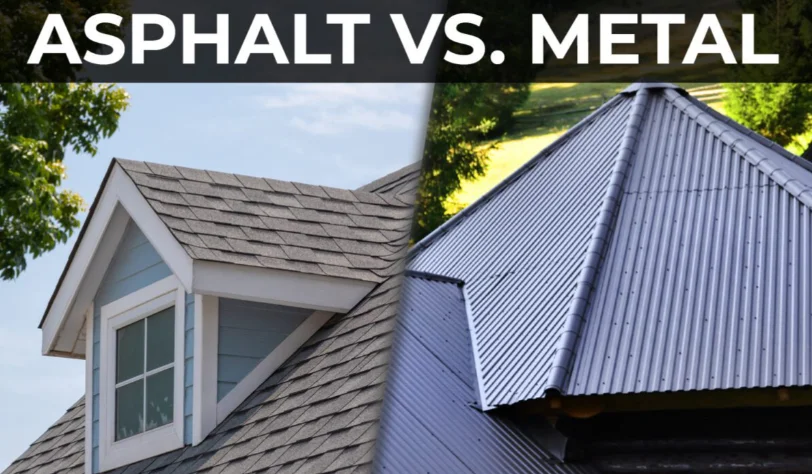Understanding their fundamental differences is essential when choosing between asphalt shingles and metal roofing. Asphalt shingles are among the most common roofing materials, known for their affordability and ease of installation. Made from a base of fiberglass or organic materials, these shingles are covered with asphalt and granules for durability. They come in various styles, colors, and shapes, making them a popular choice for homeowners seeking a cost-effective solution. On the other hand, metal roofing is made from durable materials like aluminum, steel, or copper and often lasts longer than asphalt. Metal roofs are known for their sleek and modern appearance while offering excellent resistance to harsh weather conditions. While asphalt is lightweight and easy to replace, metal roofing requires a more precise installation, adding to its overall cost. We will explore which material better suits your budget, climate, and long-term goals to help you make an informed decision.
Cost Considerations for Both Roofing Options
Cost often plays a significant role when selecting roofing materials. Asphalt shingles are generally more affordable upfront, making them an appealing choice for budget-conscious homeowners. The installation process for asphalt roofs is also quicker and simpler, reducing labor costs. On average, asphalt roofs can last 15 to 30 years, depending on maintenance and climate conditions, providing good value for their lower price. However, while more expensive initially, metal roofing offers greater long-term savings. The durability of metal roofs allows them to last 40 to 70 years or more, significantly outpacing the lifespan of asphalt shingles. This longevity reduces the need for replacements, which can save money over time. Additionally, metal roofing’s reflective properties improve energy efficiency, lowering heating and cooling costs. Although the upfront investment for a metal roof may seem daunting, its long-term value and durability make it a financially sound option for homeowners focused on future savings.
Durability and Lifespan: Which Holds Up Better?
Durability and lifespan are key considerations when comparing asphalt and metal roofing. Asphalt shingles provide reliable protection but are more prone to damage from extreme weather conditions such as hail, high winds, and heavy snowfall. Over time, exposure to UV rays can cause asphalt shingles to deteriorate, leading to cracking and granule loss. In contrast, metal roofing is designed to withstand severe weather conditions, including heavy rain, hail, and high winds. Its durability makes it suitable for regions prone to hurricanes, snowstorms, or harsh climates. Metal roofs are also resistant to fire, rot, and insect damage, giving them an edge over asphalt. While asphalt roofs may require repairs or full replacement sooner, metal roofs offer unmatched longevity with proper maintenance. The durability of a roof directly impacts its long-term performance and cost, making metal roofing an excellent choice for homeowners looking to invest in a lasting solution.
Energy Efficiency and Environmental Impact
Energy efficiency is another factor to consider when comparing asphalt and metal roofing. Metal roofing excels in this area due to its reflective properties, which help to deflect sunlight and reduce heat absorption. This keeps homes cooler during the summer, lowering energy bills and minimizing the strain on air conditioning systems. Some metal roofs are also designed with energy-efficient coatings that enhance their reflective capabilities. In contrast, asphalt shingles absorb more heat, increasing indoor temperatures and energy usage during warm seasons. While newer asphalt shingles incorporate reflective granules to improve efficiency, they still need to catch up to metal roofing regarding energy performance.
Regarding environmental impact, metal roofing is often the more sustainable option. Many metal roofs are made from recycled materials and can be fully recycled at the end of their lifespan. Asphalt shingles, on the other hand, contribute significantly to landfill waste when replaced. Choosing metal roofing aligns better with eco-conscious values and energy savings.
Installation Process and Maintenance Requirements
The installation process and maintenance needs for asphalt and metal roofs vary significantly. Asphalt shingles are lightweight and relatively easy to install, making the process faster and less labor-intensive. This reduces installation time and costs, making asphalt an appealing option for quick projects. However, asphalt roofs require regular maintenance to prevent leaks, moss growth, and shingle damage. Periodic inspections and repairs from our Mechanicville office are necessary to extend their lifespan.
On the other hand, installing a metal roof requires specialized skills and precision, as improper installation can compromise its performance and longevity. This makes metal roofing more labor-intensive and costly. However, once installed, metal roofs require minimal maintenance. They are highly resistant to weather damage, rust, and wear, eliminating the need for frequent repairs. For homeowners seeking a low-maintenance solution, metal roofing offers peace of mind despite its higher initial investment and installation complexity.
Choosing between asphalt roof installation and metal roofing depends on your budget, climate, and long-term goals. Asphalt shingles offer an affordable and versatile solution, making them ideal for homeowners seeking a cost-effective roofing option with design flexibility. However, their shorter lifespan and susceptibility to weather damage may require more frequent replacements and maintenance. In contrast, metal roofing offers exceptional durability, energy efficiency, and long-term value, making it a worthwhile investment for those willing to pay a higher upfront cost. Its ability to withstand harsh climates and low maintenance makes it a practical option for many homes. You can determine which roofing material fits your home by considering cost, aesthetics, energy efficiency, and climate suitability. Both options have unique advantages, and understanding your priorities will help you make an informed decision that enhances your home’s protection, appearance, and value for years to come.

Shannon Reyes is a seasoned writer with a knack for crafting engaging blogs on a variety of service industries, including plumbing, cleansing, moving, pest control, and roofing. With a keen eye for detail and a passion for helping readers navigate complex topics, Shannon brings her expertise to life through informative and accessible content.











